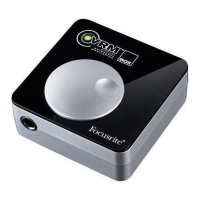
Do you have a question about the Focusrite VRM Box and is the answer not in the manual?
| output impedance | < 10 Ohms |
|---|---|
| power output into 150R | 15mV |
| power output into 50R | 30mW |
| D/A dynamic range | 120dB (A-weighted) |
|---|---|
| measured D/A dynamic range | 108dB (A-weighted) |
| clock jitter | < 250 picoseconds |
| dimensions | 68mm x 25mm x 68mm |
|---|---|
| weight | 123g |
Warnings regarding hearing damage from high volume and USB port compatibility.
Details US FCC regulations, modifications, and interference guidelines for the VRM Box.
States compliance of the VRM Box with Canadian digital apparatus standards.
Confirms adherence to EU RoHS directive and California hazardous substance laws.
The primary control for adjusting headphone listening volume.
Indicates when the VRM feature is active and functioning.
Standard 1/4" TRS connector for plugging in headphones.
Security slot for preventing theft of the VRM Box.
Connects the VRM Box to a computer for power and data.
Digital audio input for connecting external sources.
A specific note for Windows users regarding driver installation prompts.
Steps to connect and set VRM Box as the primary audio output.
Final steps: connect headphones, launch VRM software, and play audio.
Connect S/PDIF output and verify VRM Box synchronisation with the signal.
Options to choose speaker emulations and listening environments.
Controls for activating VRM and adjusting input gain for optimal signal.
Visual environment representation and indication of S/PDIF input status.
Highlights difficulties in accurate mixing due to studio limitations for producers.
Explains how VRM uses DSP and impulse responses for realistic simulations.
Lists available room models and specific loudspeaker emulations.
A comprehensive list of technical data for all emulated speakers.
Covers headphone output specs, S/PDIF input, crosstalk, and digital performance.
Describes connectors, controls, LED indicators, power, and dimensions.
Discusses latency from driver level and provides buffer size recommendations for optimal performance.
Details latency when using S/PDIF input with a DAW and VRM processing.